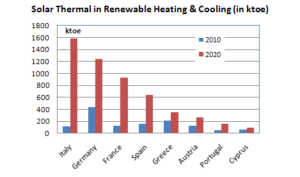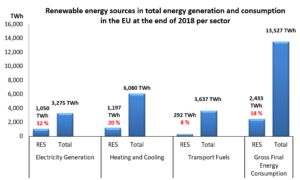“We were prepared for this Outcome”
November 29, 2010In most of the National Renewable Energy Plans (NREAPs), solar thermal was not a priority. Only 8 countries announced significant collector area and growth rates (see news here). solarthermalworld.org asked Xavier Noyon, Secretary General of the European Solar Thermal Industry Federation (ESTIF), about the reasons behind this lack of consideration, and about the actions which have to be taken now.
Photo: ESTIF
Solarthermalworld.org: In most of the NREAPs, solar thermal was hardly part of the planning. Usually, the objectives are far below the amount that could be reached. What are the reasons for that?
Xavier Noyon: Solar thermal is part of the renewable heat technologies, and as such it suffers from lower awareness and political focus than renewable electricity. Although all NREAPs acknowledge that renewable heat is the biggest component of the final energy demand and will remain so until 2020, they set objectives for renewable heat that are significantly lower than those of electricity. Further: Within renewable heat technologies, biomass and, to a certain degree, heat pumps are doing better, obviously. However, in their case, the method to calculate the announced supply figures is extremely questionable. My colleagues responsible for biomass technology estimate that there is not enough of it available to satisfy the current forecast of consumption. Our overall estimation is that the action plans’ part about renewable heat has not been considered seriously enough.
Solarthermalworld.org: In your opinion, how should the European solar thermal industry respond to the overall lack of consideration?
Xavier Noyon: We were prepared for this outcome. We knew from the beginning in which plans solar thermal would play a significant role. We will continue to do the policy and promotion work we are doing at the European level. Of course, at a national level, we are limited by the fact that our industry is not represented by an association in all European countries. Personally, I am convinced that the NREAP will provide us leverage by allowing for a concrete basis for our political requests. We can identify where and for what we should ask. To a certain extent, delivering on the current NREAP targets will also be a challenge. Let’s not forget that the so far published NREAPs foresee, on average, a nearly 15% growth for the solar thermal market per year over the next 10 years.
Solarthermalworld.org: Analysing the NREAPs, ESTIF’s calculations resulted in a share of 5.47 % for solar thermal in renewable heating and cooling in 2020, or 0.257 m² per capita. Your goal was 0.8 m² per capita. Which actions would have to be taken to achieve that aim?
Xavier Noyon: Our target and the one for the other renewable heat industries can only be reached if the rate of renovation and the standards in terms of energy efficiency in buildings increase significantly. The EPB (Energy Performance of Buildings) directive will impact only new buildings – 1% of the building stock. We need ambitious policies at a national and European level for the renovation of the existing building stock. Luckily, we share this concern with powerful industries such as the construction sector, and with the Commission, which seems to put more and more focus on energy efficiency in buildings. Of course, we simultaneously need long-term and well designed financial incentives, such as the feed-in tariffs for electricity, and other framework conditions: qualified installers, quality standards, promotion campaigns etc. Most of these basic framework conditions are in place in our major markets, but still have to be implemented in a lot of Europe’s “emerging” markets.
Solarthermalworld.org: In 8 of the EU Member States, solar thermal fared better within the framework of the NREAPs. Why do these countries put more focus on it?
Xavier Noyon: Our solar thermal champions have very different profiles; some countries are culturally solar thermal, such as Cyprus, Greece and Malta. In those countries, solar thermal is for water heating purposes only and the questions about support policy are less crucial. In countries such as Austria and Germany, the combination of environmental awareness and industrial policy has led to markets on which space heating and high-quality installations dominate. Some countries, such as France and Italy, are somewhere in between. France is seeing an explosion of the market for collective housing, and Italy has become the second market behind Germany. In all of the above-mentioned countries, there is still room for improvement, but implementing basic policies in all emerging markets, such as the UK, Poland, Hungary, Bulgaria, the Czech Republic, Slovakia etc will certainly contribute significantly.
More Information:
http://www.estif.org


